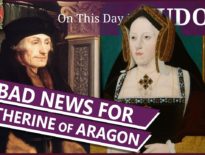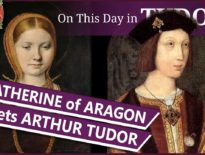On this day in Tudor history, 7th November 1485, Henry VII's first parliament attainted King Richard III and his supporters.
As well as Richard, who was referred to as Richard, late Duke of Gloucester, and a usurper, the list of those attainted for their treason in fighting against the king at Bosworth included the late John Howard, 1st Duke of Norfolk, and his son, the Earl of Surrey.
Find out who else was included and whether Parliament's actions were unusual, in today's talk.
Also on this day in Tudor history, 7th November 1541, Thomas Cranmer, Archbishop of Canterbury, visited Catherine Howard, fifth wife of King Henry VIII, in her chambers at Hampton Court Palace. Catherine had been confined to her chambers and Archbishop Cranmer's job was to get the now hysterical queen to talk, to confess. He visited her a few times over a period of 24 hours and finally got a confession from her. But what did Catherine have to say?
Find out all about Catherine Howard's confessions, and there were several, in last year’s video:
Also on this day in history:
- 1557 – Death of Sir John Arundell of Lanherne. He was buried at St Mawgan Church. Arundell served Henry VIII as Sheriff of Cornwall and Commander of troops against the rebels during the Pilgrimage of Grace. He also served in France in 1544. During Edward VI's reign, in 1549, he was imprisoned after John, Baron Russell, accused him of refusing to raise troops and of ordering the mass to be performed. He was released in June 1552.
- 1565 – Death of Sir Edward Warner, soldier, member of Parliament and Lieutenant of the Tower of London during the reigns of Edward VI and Elizabeth I. He was the gaoler of Katherine Seymour (née Grey), Countess of Hertford, who had been imprisoned for secretly marrying Edward Seymour, Earl of Hertford. Warner died in Norfolk and was buried at Little Plumstead Church in the county.
- 1568 – Baptism of Dunstan Gale, poet and author of “Pyramus and Thisbe”, at St Giles Cripplegate, London.
- 1581 – Death of Richard Davies, scholar and Bishop of St David's, in Abergwili, Carmarthenshire, in the bishop's palace. He was a friend of Matthew Parker, Archbishop of Canterbury, and undertook translations of parts of the Bible.
- 1603 – Burial of Robert Allot, literary compiler, bookseller, poet and editor of the 1599 “Wits Theater” and the 1600 “Englands Parnassus”, at St Ann Blackfriars.
Transcript:
On this day in Tudor history, 7th November 1485, just over two months after King Henry VII's forces had defeated those of King Richard III at the Battle of Bosworth Field, Henry VII's first parliament attainted Richard and his supporters.
Here is an account from Rapahel Holinshed's chronicle:
"For the establishing of all things, as well touching the preservation of his own estate, as the commendable administration of justice and preferment of the common wealth of his realme, he called his high court of parliament at Westminster the seventh day of November, wherein was attainted Richard late duke of Gloucester, calling and naming himself by usurpation, king Richard the third.
Likewise there was attainted as chief aiders and assistants to him in the battle at Bosworth, advanced against the present king, John late duke of Norfolk, Thomas earle of Surrey, Francis Lovell knight viscount Lovell, Walter Devereux knight late lord Ferrers, john lord Zouch, Robert Harrington, Richard Charleton, Richard Ratcliffe, William Berkeley of Welley, Robert Middleton, James Harrington, Robert Brakenbury, Thomas Pilkington, Walter Hopton, William Catesbie, Roger Wake, William Sapcote of the county of Huntingdon, Humphrey Stafford, William Clerke of Wenlock, Geoffrey St Germain, Richard Watkins herald of arms, Richard Revell of Derbyshire, Thomas Pulter of the county of Kent, John Welsh otherwise called Hastings, John Kendall late secretary to the said Richard late duke of Gloucester, John Bucke, Andrew Rat, and William Brampton of Burford.
In which attainder neverthelesse there were diverse clauses and provisos for the benefit of their wives and other persons, that had or might claim any right, title, or interest lawfully unto any castles, manors, lordships, towns, townships, honours, lands, tenements, rents, services, fée farms, annuities, knights fees, advowsons, reversions, remainders, and other hereditaments; whereof the said persons attainted were possessed or seized to the uses of such other persons: with a special proviso also, that the said attainder should not be prejudicial to John Catesbie knight, Thomas Revell, and William Ashby esquires, in, of, & upon the manor of Kirkebie upon Wretheke [?] in the county of Leicester, nor in, of, and upon any other lands and tenements in Kirkebie aforesaid, Melton, Somerbie, Thropseghfield, and Godebie, which they had of the gift & feoffement of Thomas Davers, & John Lie. And further, notwithstanding this attainder, diverse of the said persons afterwards were not only by the king pardoned, but also restored to their lands and livings."
In "Henry VII’s first parliament" on the History of Parliament website, Dr Hannes Kleineke, explains that the business of Henry VII's first Parliament "was naturally shaped by recent political events: the king’s tenuous title to the throne had to be fortified by parliamentary sanction, his supporters who had been attainted of treason under Edward IV and Richard III rehabilitated, the supporters of the dead Richard III attainted, and their possessions seized" and that in that "it was not very different from the Parliaments that had opened the reigns of Edward IV and Richard III in 1461 and 1484." Supporters had to be rewarded and enemies had to be punished. In a country that had been ravaged by civil war for decades, Henry VII had to make a strong show of his kingship.



Henry backdated the start of his reign to the day before Bosworth so making it treason to take up arms against him. A bit cheeky as he could just as easily have lost, but this was a contest between two men who were much more similar than we generally think.
Richard naturally as King had issued an equally insulting attainment and proclamation against Henry and his men calling him the “pretended Earl of Richmond” as the title wasn’t his by law, his ” great rebel and traitor “and numerous other things, which of course, from his point of view were true. Henry of course was now King and his reign was based on three tentative things which had to be defined in law, hence the odd contents of his first Parliament: the legitimacy of his wife to be, Elizabeth of York, his victory over the incumbent King and the righteousness of his victory and the reputation of the late King. Henry had to raise one and lessen the other. Elizabeth wasn’t legitimate. That was a legal fact, regardless of whether or not we accept that her parents really were in a bigamous marriage or not. She and her siblings, male and female had been formally declared to be illegitimate by the Parliament of Richard iii. Henry had to first be crowned and then reverse her status in Parliament. This was done, but very peculiarly.
For an Act of Parliament to be repealed it has to be first of all read in full. That was the same thing in the fifteenth century as it was now. Henry had only the first 14 lines read out and the copies destroyed. No previous Bill is destroyed but preserved. However, one original copy survived in Croyland Abbey and its contents were preserved by history. Henry also imprisoned Bishop Shillington and others in order to hide the truth. His execution of William Catesby immediately after the Battle of Bosworth is seen by some historians as also covering up the truth. He was also a chief member of Richard’s Government and symbolic of his reign. Henry’s reign though was tenuous and his claim wasn’t much better. He still had to win support if he was to hold the crown. Elizabeth and the war worn Yorkist families were the key. There was a lot to do.